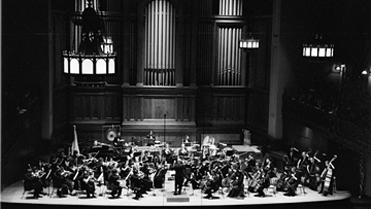








To begin a long-awaited concert such as the Chamber Orchestra's on Sept. 27 with a piece like Donald Grantham's Fantasy on Mr. Hyde's Song is a courageous thing to do, especially when the orchestra seems disinterested in the music.
The lack of energy in the opening bars was disturbing. But that was soon a thing of the past as the loud and percussive syncopated outbursts in the midst of seemingly diverse musical schema replaced the orchestra's tentative playing. The Fantasy turned out to be whimsical, humorous and eerie. The orchestra's blossoming refinement and professionalism, in both a rhythmic and a musical sense under the stylish yet serious direction of Louis Lane was also apparent.

The chamber music concert in Finney Chapel was multi-faceted. Grantham's funky contemporary piece, the exciting Symphony No. 1 of Shostakovich and the lyric Beethoven Violin Concerto in D made for an evening of diverse music, played on many levels.
On an exciting level, the Shostakovich Symphony was an experiment in quick dynamic changes and rhythmic precision; loud was loud and very loud, soft was soft and very soft. The quiet, understated opening was just a hint of the exciting Shostakovichian dissonances and their dissonant resolutions. The typically quirky character of the symphony and the awe-inspriring pauses were impressive. The romantic Sibelius-like second movement was also a feat in itself. The third and fourth movements were robust in sound.
The opening of the Beethoven concerto was scintillating. Played by Professor of Violin Gregory Fulkerson, it was at the beginning an almost out-of-body experience, with clean perfect pianissimos.
Although the cadenza in the first movement was impressive with its virtuosic double-stops, the rest of the first movement and the bulk of the Larghetto remained quite stagnant. The frequent tempo-related discrepancies between the soloist and the orchestra was frustrating despite Fulkerson's technical expertise.
It was not until the charming rondo that the orchestra decided to call upon its full potential as a chamber orchestra, and perform a decent ending in the midst of some intonation wanderings on the soloist's part.
Despite a slightly lower quality concert the audiences reaction was quite hearty and appreciative. It was not altogether a bad concert, but expectations are usually pretty high for a concert at this point in the semester and, well, they were not quite fulfilled.

Copyright © 1996, The Oberlin Review.
Volume 125, Number 5; October 4, 1996
Contact Review webmaster with suggestions or comments at ocreview@www.oberlin.edu.
Contact Review editorial staff at oreview@oberlin.edu.